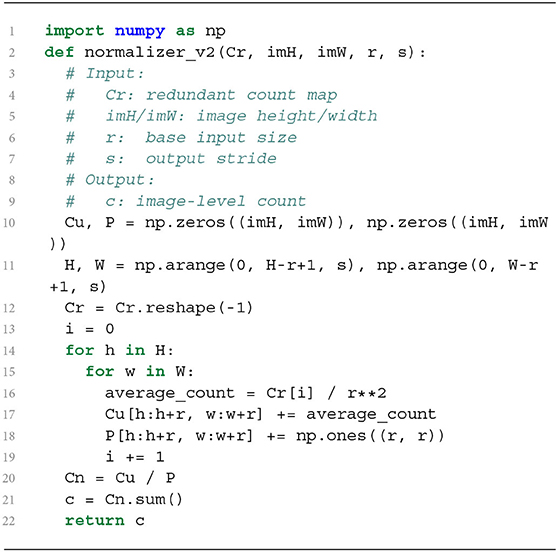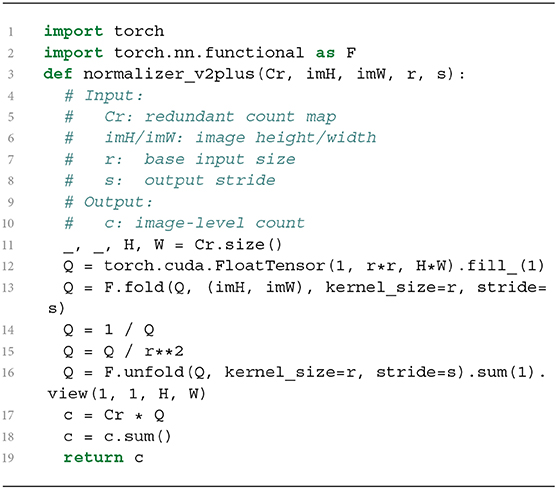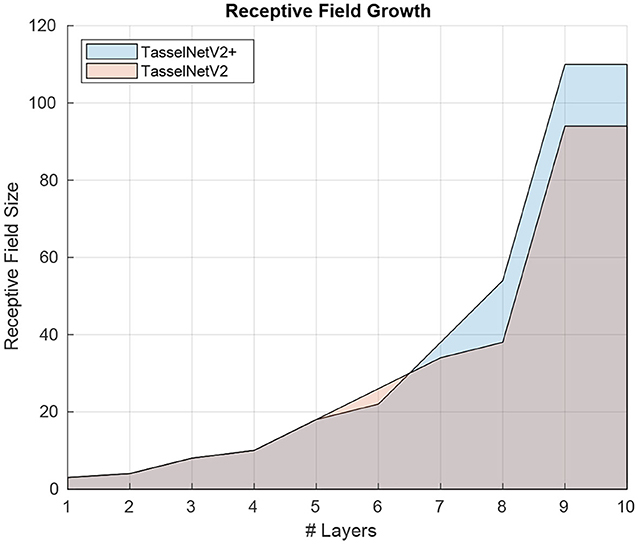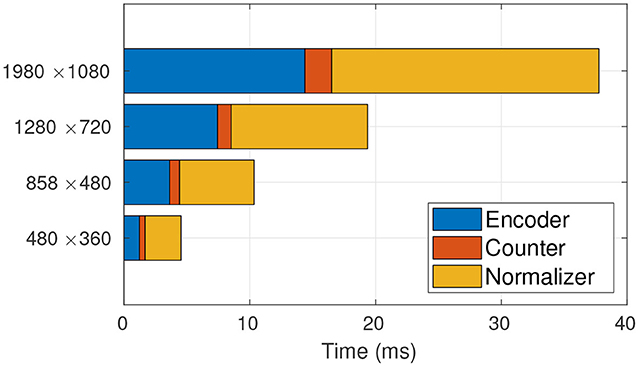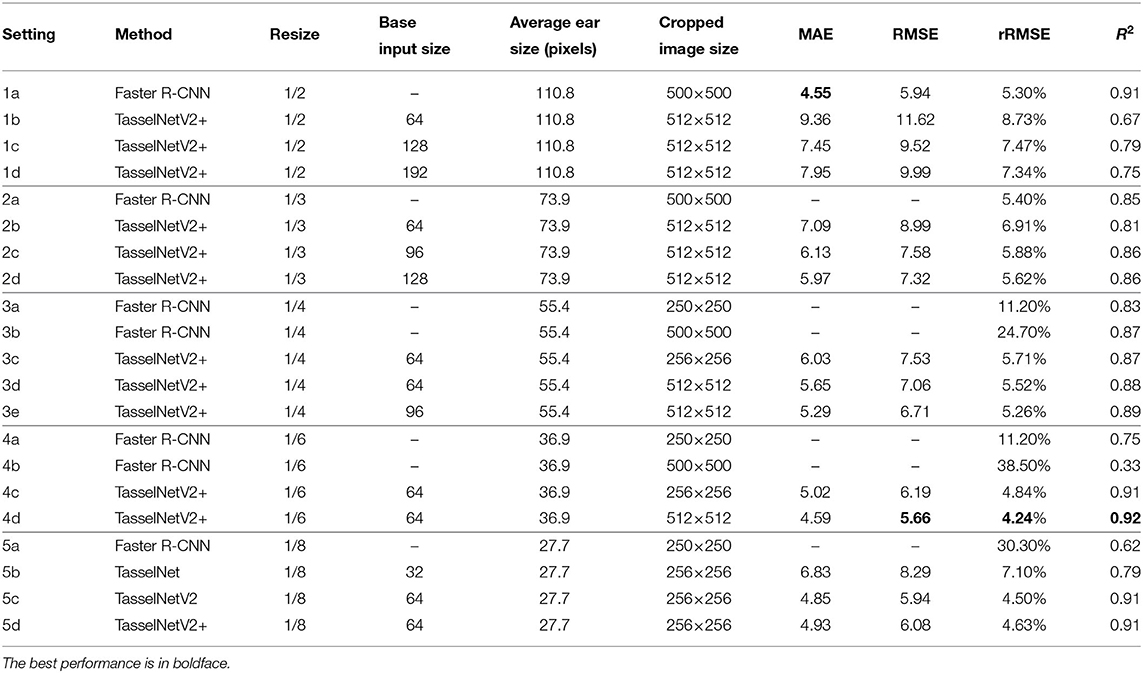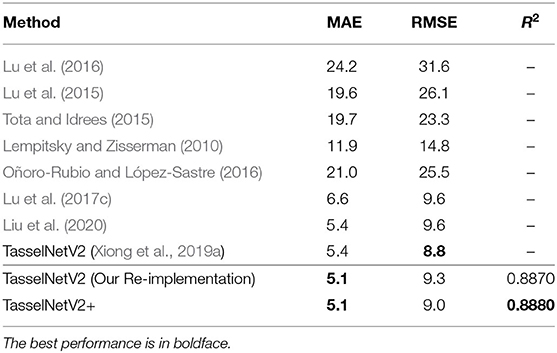- Key Laboratory of Image Processing and Intelligent Control, School of Artificial Intelligence and Automation, Huazhong University of Science and Technology, Wuhan, China
Plant counting runs through almost every stage of agricultural production from seed breeding, germination, cultivation, fertilization, pollination to yield estimation, and harvesting. With the prevalence of digital cameras, graphics processing units and deep learning-based computer vision technology, plant counting has gradually shifted from traditional manual observation to vision-based automated solutions. One of popular solutions is a state-of-the-art object detection technique called Faster R-CNN where plant counts can be estimated from the number of bounding boxes detected. It has become a standard configuration for many plant counting systems in plant phenotyping. Faster R-CNN, however, is expensive in computation, particularly when dealing with high-resolution images. Unfortunately high-resolution imagery is frequently used in modern plant phenotyping platforms such as unmanned aerial vehicles, engendering inefficient image analysis. Such inefficiency largely limits the throughput of a phenotyping system. The goal of this work hence is to provide an effective and efficient tool for high-throughput plant counting from high-resolution RGB imagery. In contrast to conventional object detection, we encourage another promising paradigm termed object counting where plant counts are directly regressed from images, without detecting bounding boxes. In this work, by profiling the computational bottleneck, we implement a fast version of a state-of-the-art plant counting model TasselNetV2 with several minor yet effective modifications. We also provide insights why these modifications make sense. This fast version, TasselNetV2+, runs an order of magnitude faster than TasselNetV2, achieving around 30 fps on image resolution of 1980 × 1080, while it still retains the same level of counting accuracy. We validate its effectiveness on three plant counting tasks, including wheat ears counting, maize tassels counting, and sorghum heads counting. To encourage the use of this tool, our implementation has been made available online at https://tinyurl.com/TasselNetV2plus.
1. Introduction
Plant counting runs through almost every critical stage in agricultural production spreading from seed breeding (Wiles and Schweizer, 1999; Mussadiq et al., 2015; Guo et al., 2018), germination (Baofeng et al., 2016; Primicerio et al., 2017), cultivation (Yu et al., 2013; Liu et al., 2018), fertilization (Vos and Frinking, 1997; Boissard et al., 2008), pollination (Guo et al., 2015; Lu et al., 2017a; Sadeghi-Tehran et al., 2017), to yield estimation (Nuske et al., 2014; Ghosal et al., 2019; Zabawa et al., 2019), and harvesting (Häni et al., 2019; Jin et al., 2019). It also plays an important role in phenotyping functional traits of plants because many traits of interest are quantity-related, such as density (Madec et al., 2019) and the number of leaves (Giuffrida et al., 2015). This task is typically addressed with manual efforts in traditional agriculture. Manual counting, however, is subjective, tedious, error-prone, labor-intensive and inefficient due to fatigue of humans. Indeed agricultural practitioners have tried to automate this task over past decades (McDonald and Chen, 1990; Gomes and Leta, 2012; Kamilaris and Prenafeta-Boldú, 2018). Unfortunately this goal is not that easy to achieve due to versatile varieties of plants and intrinsic/extrinsic variations in reality. An automated plant counting system therefore is often limited to a controlled environment or a certain application scenario such that manual counting still takes place in most regions of the world.
With the prevalence of low-end digital cameras, high-performance graphics processing units (GPUs) and effective deep learning-based technology, computer vision has received much attention in plant counting due to increased reliability and decreased costs. Plant counting has thus gradually shifted from traditional manual counting to vision-based automated solutions. The most popular solution in plant counting comes from the success of a widely-used object detection framework called Faster Region-based Convolutional Neural Network (Faster R-CNN) (Ren et al., 2015). Faster R-CNN leverages a so-called region proposal network to identify potential object locations specified by bounding boxes, then passes these boxes into a classifier to assign object labels and confidence scores, and finally suppresses overlapped boxes per the confidence scores with a non-maximum suppression operator. The population of plants can be easily inferred from the number of bounding boxes detected. Faster R-CNN has been substantially applied to plant science and agriculture engineering communities to, for example, estimate ear density (Madec et al., 2019), detect maize tassels (Liu et al., 2020), localize sweet pepper (Halstead et al., 2018), identify crop seedlings (Quan et al., 2019), etc. However, it is expensive in computation due to the use of high-capacity ImageNet-pretrained models (Deng et al., 2009), such as VGG-16 (Simonyan and Zisserman, 2014) and ResNet (He et al., 2016), especially when dealing with high-resolution images. To acquire sufficient spatial resolution, high-resolution imagery, unfortunately, cannot be avoided in modern plant phenotyping platforms such as unmanned aerial vehicles. The problem is that it is intractable to directly train/test high-resolution images with Faster R-CNN due to GPU memory limitation. It has been reported in Madec et al. (2019) that the maximum image size acceptable for training Faster R-CNN is about 500 × 500 pixels. To address this, pre-splitting images becomes a common practice during both training and inference, rendering inefficient image analysis. For instance, according to Madec et al. (2019), the inference of around 100 high-resolution images can take more than 1 h. Such inefficiency largely limits the throughput of phenotyping. In modern high-throughput plant phenotyping systems, it is important that an image analysis tool can process high-resolution images within a short period of time.
In this paper, we advocate another promising plant counting paradigm—object counting. Instead of detecting object bounding boxes, object counting directly regresses object counts from an image. This is a much direct way when only the population of objects is concerned. Indeed the transductive principle suggests never to solve a harder problem than the target application necessities (Vapnik, 1998)—estimating object counts does not have to localize where objects are. Compared with object detection, object counting has many appealing advantages, for instance: (i) cheap manual annotations: learning object counting models only requires dotted annotations, rather than more expensive bounding boxes annotations used in object detection; (ii) simplified network architectures: object detection generally builds on multi-scale architectures such as feature pyramid networks (Lin et al., 2017; Tan et al., 2019) that have extensive decoding stages, while object counting, especially for local count regression models (Lu et al., 2017c; Xiong et al., 2019a), only needs an encoder; (iii) robust to partially overlapping instances: object detection tends to under-estimate object counts due to the existence of non-maximum suppression where partially overlapping instances are likely to be suppressed, while object counting naturally takes overlapping instances into account during ground-truth generation; and (iv) light-weight computational requirement: a light-weight object counting model trained from scratch can deliver sufficiently accurate counting accuracy, while object detection models generally require ImageNet-pretrained models, with also large GPU memory consumption.
In fact, object counting is a long-standing topic in computer vision. It can at least date back to early 2000s when counting is still a by-product of face/pedestrian detectors (Viola and Jones, 2001; Dalal and Triggs, 2005). Object counting then is gradually accepted as an independent research topic after the first counting-by-regression approach (Chan et al., 2008) appears where the global object count can be regressed from an image. The idea of counting by regression is further amplified by Lempitsky and Zisserman (2010) who introduce the concept of the density map. The density map is generated from dotted annotations with Gaussian smoothing such that each pixel is assigned with a value that corresponds to the object density, which transforms counting into a dense prediction problem (Lu et al., 2019, 2020). It has become the basic building block for many object counting models (Chen et al., 2013; Arteta et al., 2014) including recent deep counting networks (Zhang et al., 2015, 2016; Sindagi and Patel, 2017; Li et al., 2018; Liu et al., 2020; Ma et al., 2019; Xiong et al., 2019b). Most state-of-the-art counting networks, however, are also inefficient due to the use of pretrained VGG-16, which hinders their applicability in high-resolution imagery in plant counting. In plant science community, many attempts have also been made for direct counting by regression (Giuffrida et al., 2015, 2018; Rahnemoonfar and Sheppard, 2017; Wu et al., 2019). In particular, in our previous work we propose TasselNet (Lu et al., 2017c), a counting network based on the idea of local count regression, to count in-field maize tassels, demonstrating that even a low-capacity network can achieve reasonably good counting accuracy. We remark that, the idea of local count regression is particularly suitable for counting plants, because this paradigm is robust to size variations of plants. Such robustness is important because a plant per se is a self-changing system such that its physical size varies over time. Xiong et al. (2019a) further extends TasselNet to TasselNetV2 and applies this new version to wheat spikes counting. We observe that TasselNetV2 turns out to be a generic tool for plant counting and even achieves comparable accuracy in crowd counting against state-of-the-art deep counting networks in computer vision. Unfortunately both TasselNet and TasselNetV2 are only implemented in a research-orientated software, i.e., MATLAB, making them infeasible for practical deployment1.
In this work, we implement a fast version of TasselNetV2, TasselNetV2+, based on PyTorch (Paszke et al., 2019). By profiling the computational bottleneck, we make several minor yet effective modifications to TasselNetV2 to improve its efficiency. These modifications are based on a novel framework view of TasselNetV2, which decomposes TasselNetV2 into an encoder, a counter and a normalizer, allowing module-specific optimization and diagnosis. In particular, we find the main computational bottleneck of TasselNetV2 lies in the poor implementation of the normalizer. We address this issue with a novel mathematically-equivalent reformulation that enables an efficient GPU-based implementation. In addition, we notice a large portion of model parameters are included in the first convolutional layer of the counter, which also introduces many floating-point calculations. Inspired by a common practice in image classification (Lin et al., 2013; He et al., 2016), we make the same observation that the first convolutional layer of the counter can be safely replaced with global average pooling without performance loss. This simple modification significantly reduces model parameters, improves efficiency, and more importantly, enables flexible adaptation to different object sizes. Further, we also slightly improve the efficiency of the encoder by moving forward the last downsampling layer. Such a modification enlarges the receptive field (RF) by 17% so that extra context can be seen by the network. Altogether these modifications significantly improve the efficiency of TasselNetV2 by more than an order of magnitude, achieving around 30 fps on image resolution of 1980 × 1080 (tested on a low-end GTX1070 GPU), as shown in Figure 1. More importantly, these modifications have no negative effect on counting accuracy. To encourage the use of this tool, we has released our implementation online. We believe TasselNetV2+ will facilitate many counting-related tasks in plant phenotyping systems. In short, we make the following contributions:
• TasselNetV2+: a fast version of TasselNetV2 with significant optimization in efficiency;
• A framework view of TasselNetV2 as a concatenation of an encoder, a counter and a normalizer, which allows module-specific optimization and diagnosis;
• A novel reformulation of local-count normalization that enables an efficient GPU-based implementation.
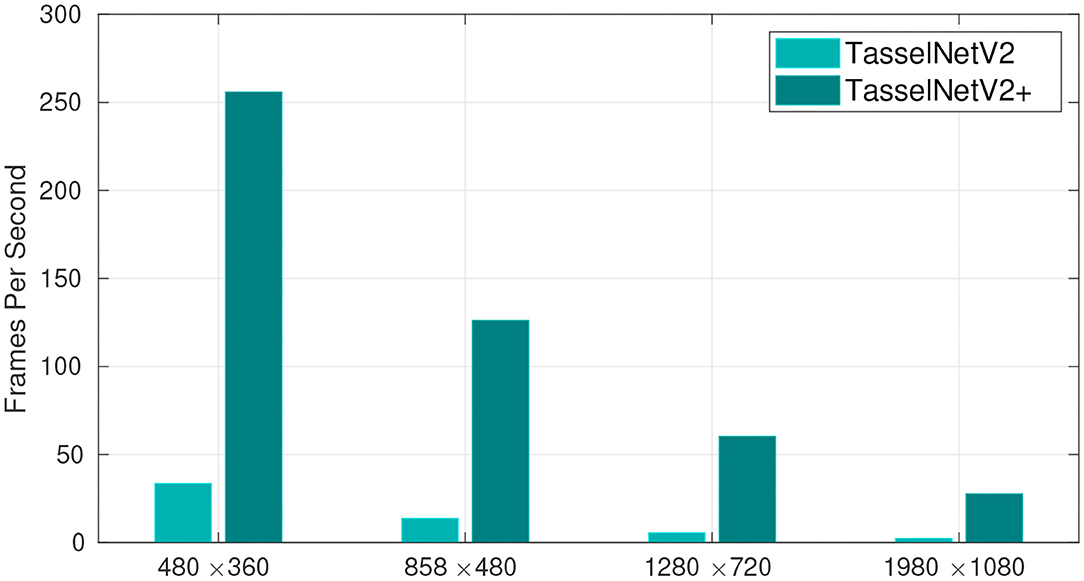
Figure 1. The number of processed frames per second with different image resolution. TasselNetV2+ is an order of magnitude faster than TasselNetV2. Frames per second are averaged over 100 independent trials on random input tested on GTX 1070 GPU, i7-8700 CPU, and 16 GB RAM.
2. Datasets and Methods
2.1. Plant Counting Datasets
Since the focus of this work is on the methodology part, we leverage three publicly available plant counting datasets in our evaluation.
The Wheat Ears Detection (WED) dataset was collected in France with a wheat field phenotyping platform using a Sony ILCE-6000 digital camera in 2017. Images were captured from a trial of 120 2 × 10 m microplots with 20 contrasting genotypes at 2.9 m distance to the ground. The image resolution was 6, 000 × 4, 000. The number of ears in each image varied from 80 to 170. The dataset included 236 images. 30, 729 wheat ears were identified and manually annotated with bounding boxes. More details about the dataset can be found in Madec et al. (2019).
The Maize Tassels Counting (MTC) dataset was collected from four experimental fields across China between 2010 and 2015 with 6 different maize cultivars. The images were captured from a 5-meter-height imaging device with a CCD digital camera (E450 Olympus). The image resolutions were 3648 × 2736, 4272 × 2848 and 3456 × 2304. The dataset had 361 images, with 186 training images and 175 testing images. The number of maize tassels varied from 0 to around 100. Each maize tassel was manually annotated with a single dot. More details can be found in Lu et al. (2017c).
The Sorghum Heads Counting (SHC) dataset was collected from a trail with 1440 plots in Australia during the 2015–2016 growing season. The images were captured using an unmanned aircraft vehicle at flight heights of 20 m and a flight speed of 3 m/s with a commercial RGB camera. The resolution of the camera was 5472 × 3648. In the released dataset, there were two subsets called “dataset1” and “dataset2” with 52 cropped images and 40 post-processed images, respectively. The cropped image resolution in dataset1 was 1154 × 1731. Forty processed images were of varied resolutions. These two subsets were chosen because only they were labeled with dotted annotations. More details can be found in Guo et al. (2018).
Some example images of the three plant counting datasets are illustrated in Figure 2.
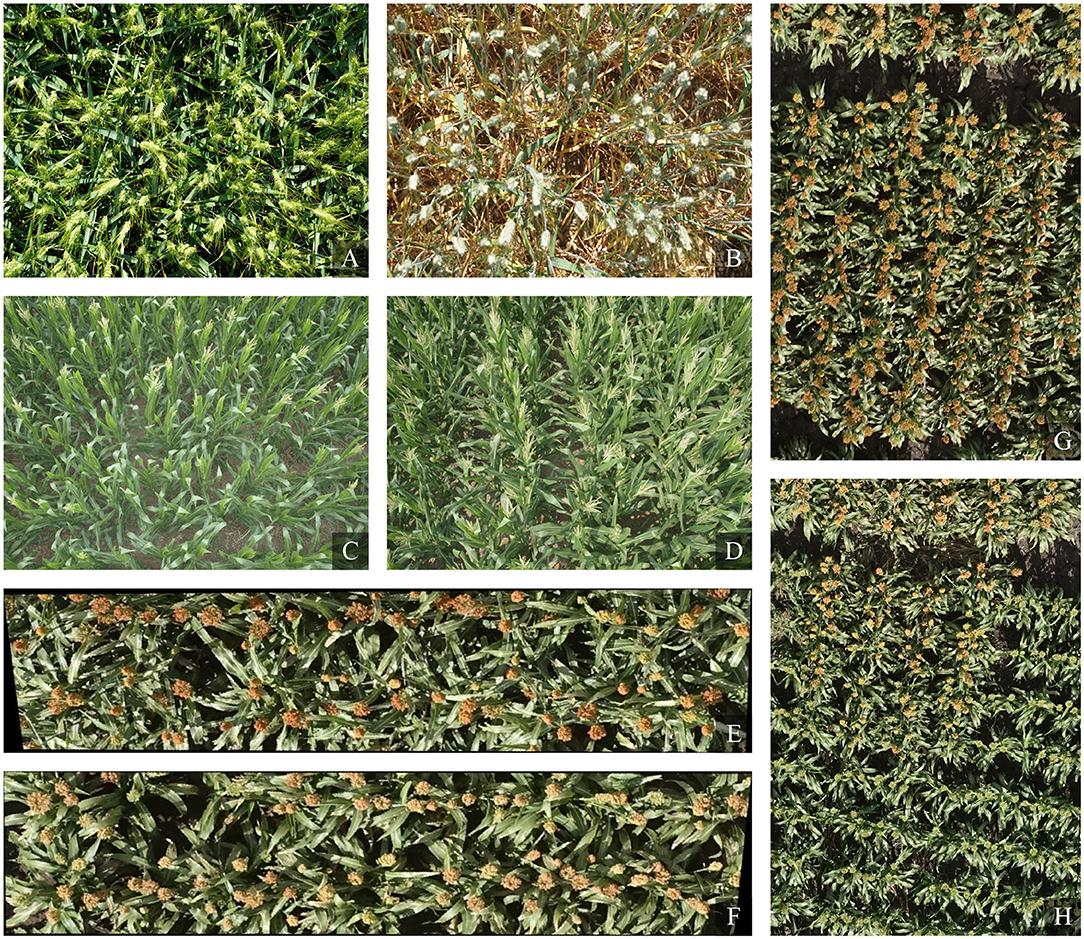
Figure 2. Example images on three plant counting datasets. Panels (A,B) are from the Wheat Ears Detection (WED) dataset, panels (C,D) are from the Maize Tassels Counting (MTC) dataset, and panels (E–H) are from the Sorghum Heads Counting (SHC) dataset.
2.2. Recapping TasselNetV2
As the baseline of this work, here we first recap TasselNetV2 (Xiong et al., 2019a). TasselNetV2 extends TasselNet (Lu et al., 2017c)—the simplest implementation of local count regression, i.e., learning a mapping from local image features to local region counts. TasselNetV2 is inspired by an observation that the theoretical RF is wasted in TasselNet such that TasselNet is weak in modeling context. It addresses this issue by changing all fully-connected layers into convolutional ones to allow arbitrary sizes of input. Instead of sampling and operating on small image patches, TasselNetV2 processes full images. In this way, hidden RF can be freed to benefit some plant counting tasks where context is an important cue, such as wheat spikes counting (Xiong et al., 2019a).
The network architecture of TasselNetV2 is shown in Figure 3. It includes 7 convolutional layers and 3 max pooling layers. Concretely, it is defined by C3(16)-M-C3(32)-M-C3(64)-C3(64)-C3(64)-M-C8(128)-C1(128)-C1(1), where Ck(m) denotes a 2D convolutional layer with m-channel k × k filters, followed by batch normalization (BN) (Ioffe and Szegedy, 2015) and ReLU (Nair and Hinton, 2010), and M is a 2-stride max pooling operator with 2 × 2 kernel size. The last C(1) is the prediction layer where BN and ReLU are not included.
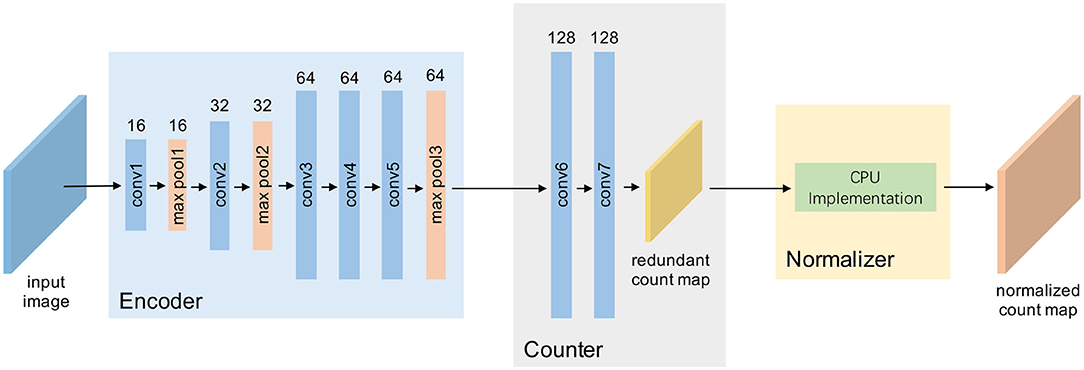
Figure 3. A framework view of TasselNetV2. Given an input image, TasselNetV2 processes it through an encoder with a few convolutional and downsampling layers, passes it into a counter to regress local counts, and finally, normalizes the local counts with a normalizer to generate the final output.
In local count regression, an image is mapped to a (redundant) count map where each local count in the count map corresponds to a r × r local region. The relative order between r and the output stride s determines whether the count map is redundant. Note that r ≥ s. The count map is redundant when r > s, because in this case every two adjacent local regions have a overlap. Only when r = s that the overlap disappears. According to the network definition above, r = 64 and s = 8 in TasselNetV2, so the resulting count map is redundant. A normalizer must follow for de-redundancy such that the sum of the final normalized count map can reflect the image count exactly. We call r × r the base input size of the network. The base input size is only related to the network architecture. This is a different concept from the input image size that can be arbitrarily large in theory. For example, given an input I ∈ ℝr×r×3, TasselNetV2 defines a transformation f such that f(I):ℝr×r×3 → ℝ; if I′ ∈ ℝH×W×3 where H, W ≫ r and are assumed to be divisible by s, then . This suggests the output size of the count map is irrelevant to the base input size when the input image size is larger than the base input size. We will use this concept extensively throughout this paper.
2.3. Profiling Computational Bottlenecks
Despite TasselNetV2 exhibits remarkable counting performance on counting maize tassels and wheat spikes (Xiong et al., 2019a), its efficiency does not meet the requirement of high-throughput high-resolution image analysis (Figure 1). It is thus natural to consider whether there is room for efficiency improvement. Before optimization, a prerequisite is to figure out where the computational bottleneck is.
From Figure 3, an important insight of this work is that, by decomposing the architecture, TasselNetV2 can be viewed as a concatenation of an encoder, a counter and a normalizer: the encoder specializes in encoding the image representation; the counter maps the image representation to the local count; and the normalizer normalizes redundant local counts and outputs the final image-level count. Such decomposition is essential to allow module-specific diagnosis and profiling.
Given the framework view of TasselNetV2, we profile the time usage of each module in detail. The profiling results are shown in Figure 4. We surprisingly find that most of time consumption comes from the normalizer, and its occupancy even increases with increased image resolution. Since the bottleneck is found, the next step is to figure out why it wastes so much time. In what follows, we discuss this problem and our solution in detail.
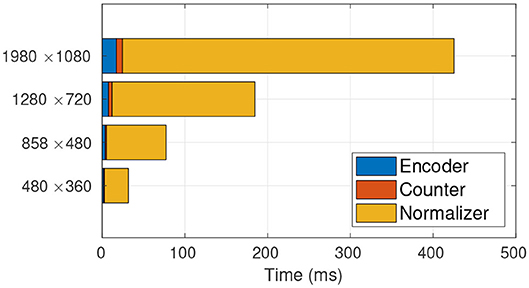
Figure 4. Time profiling of TasselNetV2. It is clear that the main computational bottleneck lies in the normalizer. From low resolution to high resolution, the normalizer takes up 91.72, 93.31, 93.62, 94.25% of the total processing time, respectively.
2.4. Reformulating Local-Count Normalizer
Let us first elaborate on how the normalizer works. As aforementioned, given an input image I ∈ ℝH×W×3, TasselNetV2 produces a redundant count map . To remove redundancy, a normalizer is followed to generate a normalized count map . Notice that the spatial resolution is first reduced by s times and then recovered to the input resolution. TasselNetV2 achieves this by averaging each local count value c ∈ Cr into to a r × r region, i.e., each element of the r × r region is assigned with an averaged count of (the sum of the local region still equals to c). By applying this rule to all local counts in Cr and rearranging them following the same spatial order and the output stride, an upsampled count map can be acquired. Cu is still redundant. TasselNetV2 addresses this by constructing a reference map P ∈ ℝH×W that records how many times each location is counted. P can be an indicator of redundancy, as visualized in Figure 5. The final normalized count map therefore can be computed by Cn = Cu ⊘ P, where ⊘ denotes the element-wise division operator. Finally, the image-level count cI can be computed by aggregating Cn, i.e.,
where Cn(x, y) is the value of Cn indexed by x and y. The normalization process above can be implemented by Algorithm 1.
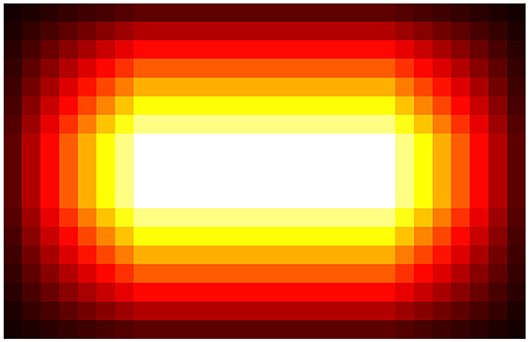
Figure 5. Visualization of redundancy. The lighter the color is, the more redundant the regions are. The redundancy gradually grows from border to center and then remains constant in central areas.
Algorithm 1 is a CPU-based sequential implementation. It is easy to verify that most time consumption takes place in the two nested for loops, leading to inefficient normalization. One possible solution may be to parallel this process with additional computational resources, while a more elegant way may be to pose the question: Can we speed up the normalizer at the algorithmic level? Our answer is positive. Our solution comes from a mathematically-equivalent reformulation of Equation (1), which takes the form
where is the vectorized version of Cr, cr(i) denotes the i-th local count of cr, and Pi indicates the r × r local region extracted from P that corresponds to cr(i). The benefit of such a reformulation is that we can evade the explicit computation of Cu and achieve per-region normalization simultaneously. In addition, Pi can be efficiently constructed with modern image manipulation operators, such as im2col in MATLAB or fold in PyTorch. By defining another vector where , Equation (2) can be further simplified to
This new formulation can be implemented by Algorithm 2. It is worth noting that Algorithm 2 is a full GPU-based implementation. We re-profile the time usage of TasselNetV2 with this new implementation. As shown in Figure 6, the time consumption of the normalizer reduces significantly.
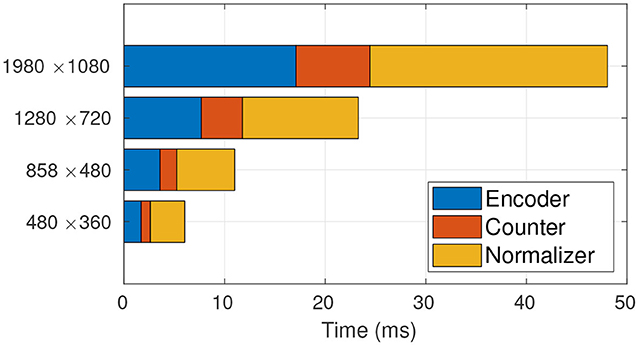
Figure 6. Time profiling of TasselNetV2 with the GPU-based normalizer. The GPU-based normalizer speeds up the inference significantly. From low resolution to high resolution, the normalizer only takes up 56.62, 52.36, 49.48, 49.15% of the total processing time, respectively.
2.5. Optimizing Encoder and Counter
After addressing the main computational bottleneck, we also take a closer look at the encoder and the counter to examine their possibility for further optimization. Indeed we find such possibility. For the counter, we notice that the number of parameter of the first convolutional layer is 8 × 8 × 64 × 128 = 524, 288, while the total number parameters of the model is 638, 993. That is to say, this single layer takes up 82.05% of model parameters. This fact motivates us to investigate the necessity of reserving such a parameter-extensive layer. Inspired by a common practice in image classification (Lin et al., 2013; He et al., 2016) where fully-connected layers are replaced with a global average pooling (GAP) layer, we apply this modification to TasselNetV2 and surprisingly find that almost no performance loss is observed (we will justify this point in section 3), which suggests the first convolutional layer in the counter can be safely replaced by GAP. Note that, the sense of “global” in GAP is relative to the base input size, rather than the input image size. It is still implemented by a standard average pooling layer, with the same kernel size compared to the size used in convolution, i.e., 8 × 8 for r = 64.
A very interesting property of introducing the GAP layer is that it allows flexible manipulation of the base input size r × r without changing the model complexity because GAP is a non-parametric layer. Allowing the change of r enables TasselNetV2+ to adapt to different object sizes in images. It is clear that, when resizing an image, object sizes change accordingly. r should also change to match the object size. For instance, if an image is upsampled by ×2, r also should be doubled. This is a hyper-parameter that needs to be tuned when choosing an appropriate image resolution in practice. Tuning r is easy in TasselNetV2+. Given the desired base input size r × r and the output stride s, one only needs to modify the kernel size of GAP to be . Note that such a modification does not affect the model complexity. We will show later in section 3 how counting performance changes with changed base input sizes.
Regarding the encoder, it is not immediately clear on how to improve its efficiency because its design is sufficiently clean. Despite there exist efficient convolutional operators such as depthwise convolution, such efficiency still stays in theory, e.g., “depthwise convolution + pointwise convolution” used in MobileNet (Howard et al., 2017) is even less efficient than standard convolution in TasselNetV2 (23.76ms vs. 16.92ms for processing an 1920 × 1080 input with the encoder). Instead we find a simple trick that can improve the encoder efficiency. The trick is to move forward the last downsampling layer, right after the third convolutional layer. This simple modification leads to an efficiency improvement from 16.92 ms to 14.39 ms on an 1920 × 1080 input. The improvement can boil down to the early decrease of spatial resolution such that conv4 and conv5 are executed on low-resolution feature maps. The modification also increases the RF by 17%, from 94 to 110, as illustrated in Figure 7. The importance of RF for plant counting has been highlighted in Xiong et al. (2019a). Such increment of RF hence allows additional context modeling.
We remark that, since the improvements to the counter and the encoder are somewhat tricky and minor, we do not declare any novelty or contribution in this part.
2.6. Meeting TasselNetV2+
Altogether the efficient normalizer, the trimmed counter, and the improved encoder construct a fast version of TasselNetV2 we call TasselNetV2+. Figure 8 highlights the improvements of TasselNetV2+ over TasselNetV2. Following the same notation in section 2.2, the architecture of TasselNetV2+ is formally defined by C3(16)-M-C3(32)-M-C3(64)-M-C3(128)-C3(128)-A8-C1(128)-C1(1), where A8 is the average pooling operator with 8 × 8 kernel size so that each inferred local count is still learned from a region of the base input size.
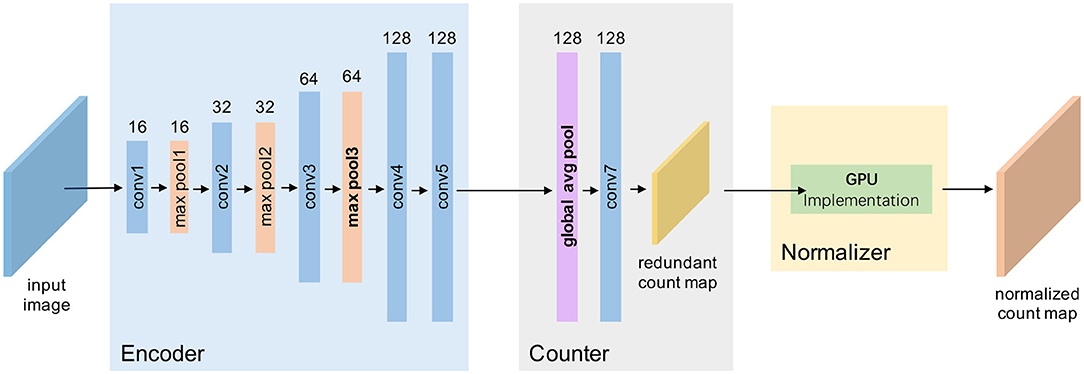
Figure 8. A framework view of TasselNetV2+. Our modifications are in boldface, including changing the downsampling behavior in the encoder, aggregating encoder features with global average pooling in the counter, and implementing a GPU-based normalizer.
To showcase the overall effect in efficiency optimization, we again profile the time usage of TasselNetV2+ in Figure 9. It can be observed that, compared with Figure 6, the time consumption of the counter decreases significantly. Now TasselNetV2+ can process an 1920 × 1080 image in less than 40 ms. To give one a sense why TasselNetV2+ is significantly faster than TasselNetV2, we further summarize the number of parameters and GFLOPs (an indicator of the amount of floating-point operations) of two models. TasselNetV2 has 639K model parameters with the GFLOPs of 29.20, while TasselNetV2+ is with 262K and 12.42 GFLOPs (GFLOPs are based on an 1920 × 1080 input). Overall TasselNetV2+ is an order of magnitude faster than TasselNetV2 per Figure 1 with less parameters and GFLOPs. In section 3, we will show that the decrease of model parameters and GFLOPs does not imply the degradation of counting accuracy; instead TasselNetV2+ achieves almost the same counting accuracy compared to TasselNetV2.
3. Results and Discussions
The goal of this work is to provide an easy-to-use tool for plant counting and to improve the efficiency of TasselNetV2. Since the efficiency issue has already been justified in the previous sections, here we mainly address the concern on whether the increased efficiency comes at the cost of decreased accuracy. We evaluate TasselNetV2+ on three plant counting tasks, wheat ears counting (Madec et al., 2019), maize tassels counting (Lu et al., 2017c), and sorghum heads counting (Guo et al., 2018).
3.1. Wheat Ears Counting
Here we report results of TasselNetV2+, TasselNetV2 (Xiong et al., 2019a), TasselNet (Lu et al., 2017c), and Faster R-CNN (Ren et al., 2015) on the WED dataset (Madec et al., 2019). Since bounding boxes annotations are given, we only use the center points computed from bounding boxes to train TasselNetV2 and TasselNetV2+. We follow the same train/validation split used in Madec et al. (2019). We also follow (Madec et al., 2019) that designs a series of experiments with different downsampling rates of , , , , and and different cropped image sizes. This allows us to directly compare TasselNetV2+ with the results of Faster R-CNN reported in Madec et al. (2019). Note that, since in high resolution, the average size of wheat ears will be larger than the RF of TasselNetV2+, we also build several variants of TasselNetV2+ with changed base input sizes.
ℓ1 loss is used for training TasselNetV2 and TasselNetV2+. 256 × 256 or 512 × 512 image patches are randomly cropped from each image with random horizontal flipping for data augmentation (only one patch is sampled from each image in each epoch). The network is trained from scratch with a batch size of 8. Model parameters are initialized from the normal distribution with a standard deviation of 0.01. The stochastic gradient descent (SGD) optimizer is used for optimization. Parameters are updated for 500 epochs, with 10, 000 iterations. The learning rate is initially set to 0.01 and reduced by 10 × at the 200-th and 400-th epoch, respectively. The mean absolute error (MAE), root mean square error (RMSE), relative RMSE, and the coefficient of determination (R2) are reported.
Results are listed in Table 1. We can make the following observations:
• TasselNetV2+ achieves counting performance comparable to TasselNetV2 (5c vs. 5d);
• The best performance reported by TasselNetV2+ is slightly better than that reported by Faster R-CNN (4d vs. 1a), while TasselNetV2+ and Faster R-CNN achieve this at different resizing ratios ( vs. );
• Compared to Faster R-CNN (1a, 2a, 3b, and 4b), the performance of TasselNetV2+ is less sensitive to the change of image resolution (1b, 2b, 3d, and 4d). We believe the reason is that Faster R-CNN requires to encode sufficiently good appearance features to detect bounding boxes. In low image resolution, degraded appearance cues may lead to decreased performance of Faster R-CNN. By contrast, local count models like TasselNetV2 and TasselNetV2+ do not require detecting bounding boxes but work by counting repetitive visual patterns. Such repetitive patterns do not have to be the whole ear and instead can be any representative part of an ear. The patterns are not likely to change significantly with changed image resolution;
• Local regression models like TasselNetV2 and TasselNetV2+ generally work well when the ear size is small (4c, 4d, 5c, and 5d). This can be a valuable property in practice because these models make it possible for large-scale phenotyping from the sky, e.g., with unmanned aircraft vehicles, where the phenotyped plants often appear to be small in images;
• The counting performance of TasselNetV2+ improves when the base input size is larger than the average ear size (2b vs. 2c vs. 2d and 1b vs. 1c vs. 1d), which means the RF of the network should be large enough to cover the objects counted. In high resolution, the performance of TasselNetV2+ slightly decreases. We think the reason is that TasselNetV2+ is not sufficiently deep (with only 5 convolutional layers), the feature representation may not be encoded well at the high resolution (details of ears are rich in high resolution).
• Compared to Faster R-CNN, TasselNetV2+ is also efficient. It is reported in Madec et al. (2019) that the inference of Faster R-CNN on the resolution requires about 1 h to iterate over the validation set, while TasselNetV2+ only takes a few seconds.
3.2. Maize Tassels Counting
Here we evaluate TasselNetV2+ on the MTC dataset (Lu et al., 2017c). Following the same practices in Lu et al. (2017c) and Xiong et al. (2019a), we downsample images to its resolution for a fair comparison. We also report performance of TasselNetV2 and other state-of-the-art methods that have reported their counting performance on this dataset.
We follow the same training configuration used in the counting wheat ears except that, 256 × 256 image patches are randomly cropped, the batch size is set to 9 (with the same 10, 000 iterations). The MAE and RMSE are used as evaluation metrics. We also report R2 for TasselNetV2 and TasselNetV2+.
Results are shown in Table 2. It is clear that TasselNetV2+ performs no worse than TasselNetV2 and other state-of-the-art methods, with the best MAE of 5.1 and a comparable RMSE of 9.0. The slightly improved performance compared to Xiong et al. (2019a) may boil down to the improved training protocol (we observe that mini-batch training leads to more stable training behavior than single-image training used in Xiong et al., 2019a).
3.3. Sorghum Heads Counting
Here we evaluate TasselNetV2+ on the SHC dataset. The SHC dataset is introduced by Guo et al. (2018) where two subsets with 52 and 40 images are labeled with dotted annotations, respectively. Since two datasets are generated in different ways, we evaluate TasselNetV2+ on them independently. For the dataset1 with 52 images, 26 images are randomly sampled for training, and the rest for testing. For the dataset2 with 40 images, 20 images are randomly sampled for training, and the rest for testing. We do not downsample the images in both training and testing.
We also follow the same training configuration used in counting wheat ears except that, 256 × 1024 image patches are randomly cropped, and the batch size is set to 5. We report MAE, RMSE and R2.
Results are shown in Table 3. Again TasselNetV2+ and TasselNetV2 achieve comparable counting performance. It is worth noting that, both models are trained with a limited number of training samples (no more than 30), which implies that TasselNetV2+ is applicable to small sample sizes. The R2 on the dataset2 is slightly poor, but we notice most inferred counts on this dataset are sufficiently accurate. Since the number of testing sample is limited, the computation of R2 may be biased by some outliers shown in Figure 11.
3.4. Further Discussions
As a summary of experiments above, we compare merits and drawbacks of Faster R-CNN, TasselNet, TasselNetV2, and TasselNetV2+ in Table 4. Faster R-CNN is accurate and has good multi-scale adaptation, but it becomes slow when scaling to high-resolution images due to large model capacity and high GPU memory consumption. TasselNet is a prototype of the plant counting model with only dotted annotations required. It points out a promising plant counting paradigm under resource-constrained conditions, but also leaves many problems unsolved. TasselNetV2 improves the accuracy and efficiency of TasselNet with the same model capacity, but still cannot tackle high-resolution images well. TasselNetV2+ inherits all the advantages of TasselNet and TasselNetV2 and is also scalable to high resolution. Despite TasselNetV2+ may not generalize well to multiple scales, we consider it a good candidate for plant counting.
Qualitative results of TasselNetV2+ on three plant counting tasks are shown in Figure 10. TasselNetV2+ infers accurate counts with strong/weak responses on plant/non-plant regions. The resulting count map can be an useful auxiliary cue to benefit related tasks such as detection or segmentation. Note that, TasselNetV2+ are applied to these plant counting tasks with the same architecture and almost the same hyper-parameters (we only slightly vary the batch size to ensure the same number of iterations during parameters updating).
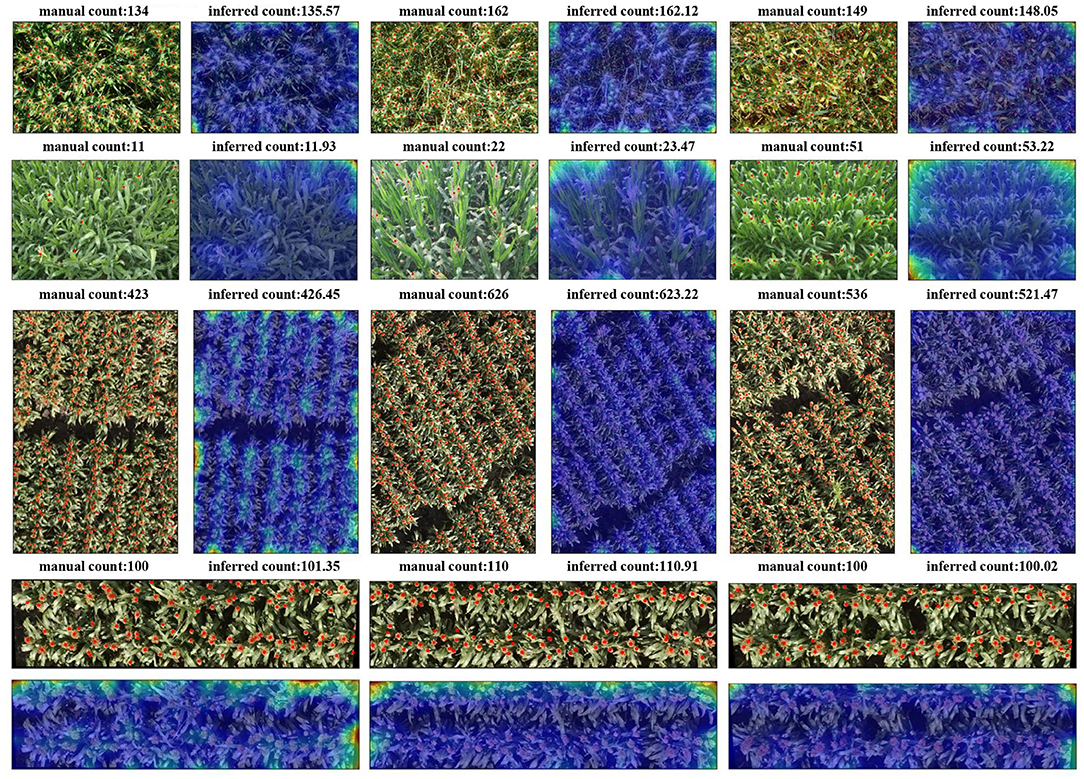
Figure 10. Qualitative results of TasselNetV2+ on three plant counting dataset. From top to bottom, the wheat ears detection dataset, maize tassels counting dataset, sorghum heads counting—dataset1, and sorghum heads counting—dataset2. Red points are manual annotations.
We further compare the manual counts and inferred counts of TasselNetV2+ on three counting tasks in Figure 11. A strong correlation between manual counts and inferred counts is observed on the WED, MTC, and SHC-dataset1 datasets, with R2 of 0.9179, 0.8880 and 0.9587, respectively. On the SHC-dataset2, the R2 is slightly poor. We believe the reason is that the points are too sparse such that R2 can be easily affected by few outliers. Most predictions are sufficiently accurate. We also observe that on the MTC dataset, a set of samples are underestimated. This is because this dataset is the most challenging one with a large data shift between training and testing set. Models learned on the training set may not generalize well to the testing set with significant variations in plant cultivars, illumination changes, and poses. In this case, the idea of domain adaptation may be applied to fill the performance loss (Lu et al., 2017b, 2018).
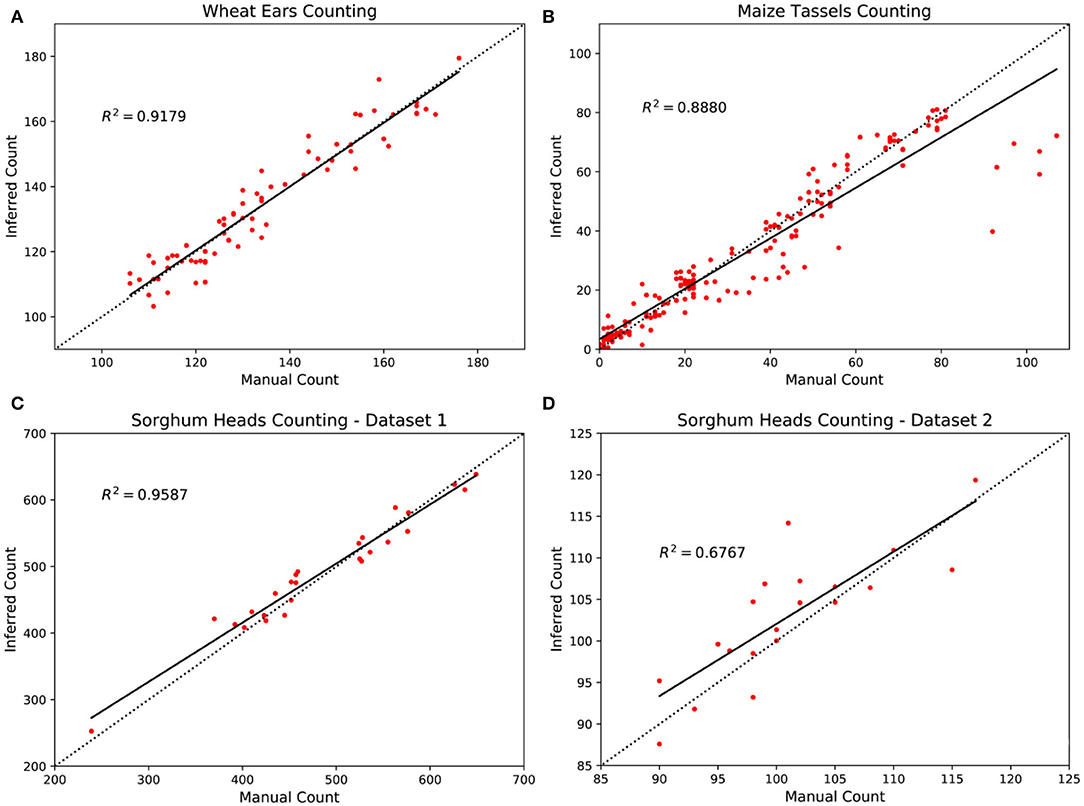
Figure 11. Comparison between inferred counts and manual counts with TasselNetV2+ in four plant counting datasets. (A) Wheat ears counting, (B) maize tassels counting, (C) sorghum heads counting—dataset1, and (D) sorghum heads counting—dataset2.
All evaluation results above suggest the general applicability of TasselNetV2+ in plant counting, especially when only the count value is the output of interest. However, an application note is that, TasselNetV2+ may have limited adaptation to scale variations, e.g., for a model trained on images captured at 5 m height will significantly degrade when testing on images captured at 10 m height. This is because TasselNetV2+ is inherently not a multi-scale model. Fortunately practitioner often have consistent image capturing plans, so this may not be a problem to deploy TasselNetV2+ in reality.
4. Conclusion
In high-throughput phenotyping systems, the term “throughput” is closely related to the efficiency of data analysis algorithms. Targeting plant counting, we present TasselNetV2+, a fast implementation of a state-of-the-art plant counting model TasselNetV2, to deal with high-throughput counting from high-resolution imagery. This new implementation is inspired by a time profiling that the computational bottleneck of TasselNetV2 lies in the normalizer. We therefore improve this part with a novel mathematically-equivalent formulation that enables a fast GPU implementation. TasselNetV2+ shows a clear advantage in efficiency on processing high-resolution images. Compared to Faster R-CNN, it also demonstrates its effectiveness and robustness in changed image resolution.
We believe our new implementation will encourage many real-time applications in phenotyping plant counts. An interesting application scenario would be that, images are directly processed right after capturing on the unmanned aircraft vehicles, instead of being sent back for post-processing. It would also be interesting to see applications of TasselNetV2+ to other plant species. For future work, we plan to enhance the scale adaptation of the model.
Data Availability Statement
All datasets generated for this study are included in the article/supplementary material.
Author Contributions
HL proposed the idea of TasselNetV2+, implemented TasselNetV2 and TasselNetV2+ in PyTorch, conducted the experiments, analyzed the results, drafted, and revised the manuscript. ZC provided the funding and supervised the study. All authors contributed to the article and approved the submitted version.
Funding
This work was supported by the Natural Science Foundation of China under Grant No. 61876211.
Conflict of Interest
The authors declare that the research was conducted in the absence of any commercial or financial relationships that could be construed as a potential conflict of interest.
Acknowledgments
The authors would like to thank Liang Liu for organizing figures.
Footnote
1. ^The MATLAB implementation of TasselNetV2 can be found at https://tinyurl.com/TasselNetV2.
References
Arteta, C., Lempitsky, V., Noble, J. A., and Zisserman, A. (2014). “Interactive object counting,” in European Conference on Computer Vision (Zurich: Springer), 504–518. doi: 10.1007/978-3-319-10578-9_33
Baofeng, S., Jinru, X., Chunyu, X, Yuyang, S., and Fuentes, S. (2016). Digital surface model applied to unmanned aerial vehicle based photogrammetry to assess potential biotic or abiotic effects on grapevine canopies. Int. J. Agric. Biol. Eng. 9, 119–130. doi: 10.3965/j.ijabe.20160906.2908
Boissard, P., Martin, V., and Moisan, S. (2008). A cognitive vision approach to early pest detection in greenhouse crops. Comput. Electron. Agric. 62, 81–93. doi: 10.1016/j.compag.2007.11.009
Chan, A. B., Liang, Z. S. J., and Vasconcelos, N. (2008). “Privacy preserving crowd monitoring: counting people without people models or tracking,” in Proc. IEEE Conference on Computer Vision and Pattern Recognition (CVPR) (Anchorage, AK), 1–7. doi: 10.1109/CVPR.2008.4587569
Chen, K., Gong, S., Xiang, T., and Change Loy, C. (2013). “Cumulative attribute space for age and crowd density estimation,” in Proc. IEEE Conference on Computer Vision and Pattern Recognition (Portland, OR), 2467–2474. doi: 10.1109/CVPR.2013.319
Dalal, N., and Triggs, B. (2005). “Histograms of oriented gradients for human detection,” in IEEE Conference on Computer Vision and Pattern Recognition (CVPR) (San Diego, CA: IEEE), 886–893. doi: 10.1109/CVPR.2005.177
Deng, J., Dong, W., Socher, R., Li, L.-J., Li, K., and Fei-Fei, L. (2009). “Imagenet: a large-scale hierarchical image database,” in Proc. IEEE Conference on Computer Vision and Pattern Recognition (CVPR) (Miami, FL: IEEE), 248–255. doi: 10.1109/CVPR.2009.5206848
Ghosal, S., Zheng, B., Chapman, S. C., Potgieter, A. B., Jordan, D. R., Wang, X., et al. (2019). A weakly supervised deep learning framework for sorghum head detection and counting. Plant Phenom. 2019:1525874. doi: 10.34133/2019/1525874
Giuffrida, M. V., Doerner, P., and Tsaftaris, S. A. (2018). Pheno-deep counter: a unified and versatile deep learning architecture for leaf counting. Plant J. 96, 880–890. doi: 10.1111/tpj.14064
Giuffrida, M. V., Minervini, M., and Tsaftaris, S. (2015). “Learning to count leaves in rosette plants,” in Proc. Computer Vision Problems in Plant Phenotyping (CVPPP) (Swansea, UK: BMVA Press), 1.1–1.13. doi: 10.5244/C.29.CVPPP.1
Gomes, J. F. S., and Leta, F. R. (2012). Applications of computer vision techniques in the agriculture and food industry: a review. Eur. Food Res. Technol. 235, 989–1000. doi: 10.1007/s00217-012-1844-2
Guo, W., Fukatsu, T., and Ninomiya, S. (2015). Automated characterization of flowering dynamics in rice using field-acquired time-series rgb images. Plant Methods 11:7. doi: 10.1186/s13007-015-0047-9
Guo, W., Zheng, B., Potgieter, A. B., Diot, J., Watanabe, K., Noshita, K., et al. (2018). Aerial imagery analysis-quantifying appearance and number of sorghum heads for applications in breeding and agronomy. Front. Plant Sci. 9:1544. doi: 10.3389/fpls.2018.01544
Halstead, M., McCool, C., Denman, S., Perez, T., and Fookes, C. (2018). Fruit quantity and ripeness estimation using a robotic vision system. IEEE Robot. Automat. Lett. 3, 2995–3002. doi: 10.1109/LRA.2018.2849514
Häni, N., Roy, P., and Isler, V. (2019). A comparative study of fruit detection and counting methods for yield mapping in apple orchards. J. Field Robot. 37, 263–282. doi: 10.1002/rob.21902
He, K., Zhang, X., Ren, S., and Sun, J. (2016). “Deep residual learning for image recognition,” in Proc. IEEE Conference on Computer Vision and Pattern Recognition (CVPR) (Las Vegas, NV), 770–778. doi: 10.1109/CVPR.2016.90
Howard, A. G., Zhu, M., Chen, B., Kalenichenko, D., Wang, W., Weyand, T., et al. (2017). Mobilenets: efficient convolutional neural networks for mobile vision applications. arXiv [Preprint]. arXiv:1704.04861.
Ioffe, S., and Szegedy, C. (2015). “Batch normalization: accelerating deep network training by reducing internal covariate shift,” in Proc. International Conference on Machine Learning (ICML) (Lille), 448–456.
Jin, X., Madec, S., Dutartre, D., de Solan, B., Comar, A., Baret, F., et al. (2019). High-throughput measurements of stem characteristics to estimate ear density and above-ground biomass. Plant Phenom. 2019:4820305. doi: 10.34133/2019/4820305
Kamilaris, A., and Prenafeta-Boldú, F. X. (2018). Deep learning in agriculture: a survey. Comput. Electron. Agric. 147, 70–90. doi: 10.1016/j.compag.2018.02.016
Lempitsky, V., and Zisserman, A. (2010). “Learning to count objects in images,” in Advances in Neural Information Processing Systems (NIPS) (Vancouver, BC), 1324–1332.
Li, Y., Zhang, X., and Chen, D. (2018). “CSRNet: dilated convolutional neural networks for understanding the highly congested scenes,” in Proc. IEEE Conference on Computer Vision and Pattern Recognition (CVPR) (Salt Lake City, UT), 1091–1100. doi: 10.1109/CVPR.2018.00120
Lin, M., Chen, Q., and Yan, S. (2013). “Network in network,” in Proc. International Conference on Learning Representations (ICLR) (Scottsdale, AZ), 1–10.
Lin, T.-Y., Dollár, P., Girshick, R., He, K., Hariharan, B., and Belongie, S. (2017). “Feature pyramid networks for object detection,” in Proc. IEEE Conference on Computer Vision and Pattern Recognition (CVPR) (Honolulu, HI), 2117–2125. doi: 10.1109/CVPR.2017.106
Liu, L., Lu, H., Xiong, H., Xian, K., Cao, Z., and Shen, C. (2020). Counting objects by blockwise classification. IEEE Trans. Circ. Syst. Video Technol. 30, 3513–3527.
Liu, T., Yang, T., Li, C., Li, R., Wu, W., Zhong, X., et al. (2018). A method to calculate the number of wheat seedlings in the 1st to the 3rd leaf growth stages. Plant Methods 14, 1–14. doi: 10.1186/s13007-018-0369-5
Liu, Y., Cen, C., Che, Y., Ke, R., Ma, Y., and Ma, Y. (2020). Detection of maize tassels from UAV RGB imagery with faster R-CNN. Remote Sens. 12:338. doi: 10.3390/rs12020338
Lu, H., Cao, Z., Xiao, Y., Fang, Z., and Zhu, Y. (2017a). Towards fine-grained maize tassel flowering status recognition: dataset, theory and practice. Appl. Soft Comput. 56, 34–45. doi: 10.1016/j.asoc.2017.02.026
Lu, H., Cao, Z., Xiao, Y., Fang, Z., Zhu, Y., and Xian, K. (2015). Fine-grained maize tassel trait characterization with multi-view representations. Comput. Electron. Agric. 118, 143–158. doi: 10.1016/j.compag.2015.08.027
Lu, H., Cao, Z., Xiao, Y., Li, Y., and Zhu, Y. (2016). Region-based colour modelling for joint crop and maize tassel segmentation. Biosyst. Eng. 147, 139–150. doi: 10.1016/j.biosystemseng.2016.04.007
Lu, H., Cao, Z., Xiao, Y., and Zhu, Y. (2017b). Two-dimensional subspace alignment for convolutional activations adaptation. Pattern Recogn. 71, 320–336. doi: 10.1016/j.patcog.2017.06.010
Lu, H., Cao, Z., Xiao, Y., Zhuang, B., and Shen, C. (2017c). TasselNet: counting maize tassels in the wild via local counts regression network. Plant Methods 13, 79–95. doi: 10.1186/s13007-017-0224-0
Lu, H., Dai, Y., Shen, C., and Xu, S. (2019). “Indices matter: learning to index for deep image matting,” in Proc. IEEE/CVF Conference on Computer Vision (ICCV) (Seoul), 3266–3275. doi: 10.1109/ICCV.2019.00336
Lu, H., Dai, Y., Shen, C., and Xu, S. (2020). Index networks. IEEE Trans. Pattern Anal. Mach. Intell. doi: 10.1109/TPAMI.2020.3004474. [Epub ahead of print].
Lu, H., Shen, C., Cao, Z., Xiao, Y., and van den Hengel, A. (2018). An embarrassingly simple approach to visual domain adaptation. IEEE Trans. Image Process. 27, 3403–3417. doi: 10.1109/TIP.2018.2819503
Ma, Z., Wei, X., Hong, X., and Gong, Y. (2019). “Bayesian loss for crowd count estimation with point supervision,” in Proc. IEEE International Conference on Computer Vision (ICCV) (Seoul), 6142–6151. doi: 10.1109/ICCV.2019.00624
Madec, S., Jin, X., Lu, H., De Solan, B., Liu, S., Duyme, F., et al. (2019). Ear density estimation from high resolution RGB imagery using deep learning technique. Agric. Forest Meteorol. 264, 225–234. doi: 10.1016/j.agrformet.2018.10.013
McDonald, T., and Chen, Y. (1990). Application of morphological image processing in agriculture. Trans. ASAE 33, 1346–1352. doi: 10.13031/2013.31479
Mussadiq, Z., Laszlo, B., Helyes, L., and Gyuricza, C. (2015). Evaluation and comparison of open source program solutions for automatic seed counting on digital images. Comput. Electron. Agric. 117, 194–199. doi: 10.1016/j.compag.2015.08.010
Nair, V., and Hinton, G. E. (2010). “Rectified linear units improve restricted Boltzmann machines,” in Proc. International Conference on Machine Learning (ICML) (Haifa), 807–814.
Nuske, S., Wilshusen, K., Achar, S., Yoder, L., Narasimhan, S., and Singh, S. (2014). Automated visual yield estimation in vineyards. J. Field Robot. 31, 837–860. doi: 10.1002/rob.21541
Oñoro-Rubio D. and López-Sastre, R. J. (2016). “Towards perspective-free object counting with deep learning,” in Proc. European Conference on Computer Vision (ECCV) (Amsterdam), 615–629. doi: 10.1007/978-3-319-46478-7_38
Paszke, A., Gross, S., Massa, F., Lerer, A., Bradbury, J., Chanan, G., et al. (2019). “Pytorch: an imperative style, high-performance deep learning library,” in Advances in Neural Information Processing Systems (NeurIPS) (Vancouver, BC), 8024–8035.
Primicerio, J., Caruso, G., Comba, L., Crisci, A., Gay, P., Guidoni, S., et al. (2017). Individual plant definition and missing plant characterization in vineyards from high-resolution UAV imagery. Eur. J. Remote Sens. 50, 179–186. doi: 10.1080/22797254.2017.1308234
Quan, L., Feng, H., Lv, Y., Wang, Q., Zhang, C., Liu, J., et al. (2019). Maize seedling detection under different growth stages and complex field environments based on an improved faster R-CNN. Biosyst. Eng. 184, 1–23. doi: 10.1016/j.biosystemseng.2019.05.002
Rahnemoonfar, M., and Sheppard, C. (2017). Deep count: fruit counting based on deep simulated learning. Sensors 17:905. doi: 10.3390/s17040905
Ren, S., He, K., Girshick, R., and Sun, J. (2015). “Faster R-CNN: towards real-time object detection with region proposal networks,” in Advances in Neural Information Processing Systems (NIPS) (Montréal, QC), 91–99.
Sadeghi-Tehran, P., Sabermanesh, K., Virlet, N., and Hawkesford, M. J. (2017). Automated method to determine two critical growth stages of wheat: heading and flowering. Front. Plant Sci. 8:252. doi: 10.3389/fpls.2017.00252
Simonyan, K., and Zisserman, A. (2014). “Very deep convolutional networks for large-scale image recognition,” in Proc. International Conference on Learning Representations (ICLR) (Banff, AB), 1–14.
Sindagi, V. A., and Patel, V. M. (2017). “Generating high-quality crowd density maps using contextual pyramid CNNs,” in Proc. IEEE International Conference on Computer Vision (ICCV) (Venice), 1879–1888. doi: 10.1109/ICCV.2017.206
Tan, M., Pang, R., and Le, Q. V. (2019). Efficientdet: scalable and efficient object detection. arXiv [Preprint]. arXiv:1911.09070. doi: 10.1109/CVPR42600.2020.01079
Viola, P., and Jones, M. (2001). “Rapid object detection using a boosted cascade of simple features,” in Proc. IEEE Conference on Computer Vision and Pattern Recognition (CVPR) (Kauai, HI: IEEE), I-511–I-518. doi: 10.1109/CVPR.2001.990517
Vos, J., and Frinking, H. (1997). Nitrogen fertilization as a component of integrated crop management of hot pepper (Capsicum spp.) under tropical lowland conditions. Int. J. Pest Manage. 43, 1–10. doi: 10.1080/096708797228915
Wiles, L. J., and Schweizer, E. E. (1999). The cost of counting and identifying weed seeds and seedlings. Weed Sci. 47, 667–673. doi: 10.1017/S0043174500091311
Wu, J., Yang, G., Yang, X., Xu, B., Han, L., and Zhu, Y. (2019). Automatic counting of in situ rice seedlings from UAV images based on a deep fully convolutional neural network. Remote Sens. 11:691. doi: 10.3390/rs11060691
Xiong, H., Cao, Z., Lu, H., Madec, S., Liu, L., and Shen, C. (2019a). Tasselnetv2: in-field counting of wheat spikes with context-augmented local regression networks. Plant Methods 15:150. doi: 10.1186/s13007-019-0537-2
Xiong, H., Lu, H., Liu, C., Liu, L., Cao, Z., and Shen, C. (2019b). “From open set to closed set: counting objects by spatial divide-and-conquer,” in Proc. IEEE International Conference on Computer Vision (ICCV) (Seoul), 8362–8371. doi: 10.1109/ICCV.2019.00845
Yu, Z., Cao, Z., Wu, X., Bai, X., Qin, Y., Zhuo, W., et al. (2013). Automatic image-based detection technology for two critical growth stages of maize: emergence and three-leaf stage. Agric. Forest Meteorol. 174, 65–84. doi: 10.1016/j.agrformet.2013.02.011
Zabawa, L., Kicherer, A., Klingbeil, L., Milioto, A., Topfer, R., Kuhlmann, H., et al. (2019). “Detection of single grapevine berries in images using fully convolutional neural networks,” in Proc. IEEE Conference on Computer Vision and Pattern Recognition (CVPR) Workshops (Long Beach, CA), 1–9. doi: 10.1109/CVPRW.2019.00313
Zhang, C., Li, H., Wang, X., and Yang, X. (2015). “Cross-scene crowd counting via deep convolutional neural networks,” in Proc. IEEE International Conference on Computer Vision (ICCV) (Boston, MA), 833–841. doi: 10.1109/CVPR.2015.7298684
Keywords: plant counting, real-time processing, wheat ears, maize tassels, sorghum heads, pytorch implementation
Citation: Lu H and Cao Z (2020) TasselNetV2+: A Fast Implementation for High-Throughput Plant Counting From High-Resolution RGB Imagery. Front. Plant Sci. 11:541960. doi: 10.3389/fpls.2020.541960
Received: 11 March 2020; Accepted: 13 November 2020;
Published: 07 December 2020.
Edited by:
Roger Deal, Emory University, United StatesReviewed by:
Emanuel Peres, University of Trás-os-Montes and Alto Douro, PortugalJiwan Han Han, Aberystwyth University, United Kingdom
Copyright © 2020 Lu and Cao. This is an open-access article distributed under the terms of the Creative Commons Attribution License (CC BY). The use, distribution or reproduction in other forums is permitted, provided the original author(s) and the copyright owner(s) are credited and that the original publication in this journal is cited, in accordance with accepted academic practice. No use, distribution or reproduction is permitted which does not comply with these terms.
*Correspondence: Zhiguo Cao, emdjYW9AaHVzdC5lZHUuY24=
 Hao Lu
Hao Lu Zhiguo Cao
Zhiguo Cao